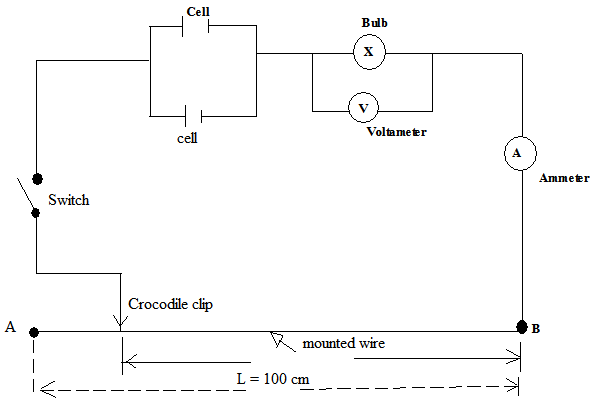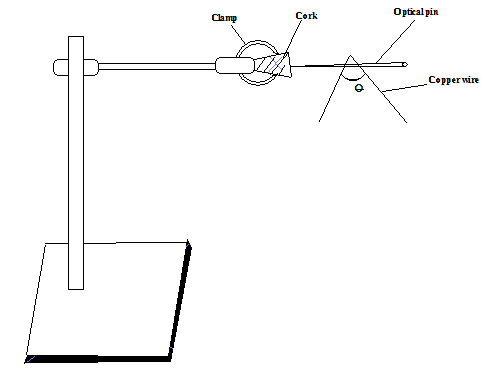INSTRUCTIONS
- Answer all the questions in this paper
- You are supposed to spend the first 15 minutes of the 2 1/4hours allowed for this paper reading the whole paper carefully before starting your work.
- Marks are given for clear record of the observations made, their suitability and accuracy and the use made of them.
- Candidates are advised to record observations as soon as they are made
- Mathematical table and electronic calculators may be used.
Question 1
You are provided with the following apparatus
- Two dry cells
- A cell holder
- A bulb
- A voltameter
- An ammeter
- A switch
- Amounted resistance wire labelled AB
- Set up the apparatus as shown in the circuit below.
- With the crocodile clip at A (ie L = 100cm) take the voltameter reading (V) and the ammeter reading (I). Record V and I in the table below.
(7 marks)Length l(cm) 100 80 60 40 20 0 Voltage (V) Current I (A) - Repeat the procedure in (b) above for the lengths shown and complete the table above.
- State the changes you observe on the bulb as L decrease from A. (2 marks)
- Plot a graph of voltage against length (cm) (5 marks)\
- What physical quantity does the slope of the graph represent at any given point. (2 marks)
- From your graph determine the value of voltage at length L = 70cm. (2 marks)
- Use your graph to describe how the physical quantity in (e) above is affected as the current increases. Explain why. (2 marks)
Question 2
You are provided with the following apparatus
- A complete stand
- Copper wire (wire length about 30cm)
- A stop watch
- A protractor
- A meter rule
- Corked optical pin
Procedure
- Measure the length L of the copper wire.
L = .................................................. m (1 mark) - Bend the wire to form an angle O of 60°, suspend it from the corked optical pin as shown in the diagram below.
- Give it a small displacement so that it oscillates about a point on the pin. Measure the time, t(s) for 10 oscillations of the wire.
t = ................................................. (s) (1 mark) - Repeat the procedure (b) above for the values of O = 70°, 80°, 90°, 100°, 110°.
- Record and complete the results in the table below.
(7 marks)θ (°) 60 70 80 90 100 110 Cos ½θ Time for 10 oscillations, t (s) Periodic time T (s) T 2 (s2) 1/T2 (s-2) - On the grid provided, plot a graph of 1/T2 (s-2) against Cos ½θ. (5 marks)
- Determine the slope. (3 marks)
- Given that the graph is related by the equation 1/T2 = 8π2LCos ½θ, determine the value of constant g.
g (3 marks)
CONFIDENTIAL
Question 1
Each candidate should have the following.
- Two dry cells (1.5v) D - size
- Cell holder(s) to enable parallel connection
- A bulb (1.5v)
- A voltameter
- An ammeter
- A switch
- Mounted resistance wire labelled AB
(The wire is SWG 32 mounted on a metre rule on a mm sale.)
Question 2
- Complete stand
- Copper wire (length of about 30cm)
- A stop watch
- A protractor
- A meter rule
- Corked optical pin

MARKING SCHEME
-
Length l(cm) 100 80 60 40 20 0 Voltage (V) 0.10 0.15 0.20 0.2 0.45 1.00 Current I (A) 0.04 0.05 0.07 0.09 0.12 0.16 - The bulb lights more brightly. (2 marks)
- Graph should be a smooth curve with positive slope
A - 1mk
S - 1mk
P - 2 mks
C - 1 mk
Total (5 mks) - The resistance of the bulb. (2 marks)
- Voltage at length L = 70cm
Candidate value from the his/her graph.
showing how to get it ....(1 mark) 0.75 ±.1
Writing the value ...............1 mark - as the current increases, the resistance also increases hence the bulb glows more brightly
- L = 0.3m (1 mark)
- t = 5.82s ( 1 mark)
θ (°) 60 70 80 90 100 110 Cos ½θ 5.82 6.42 6.96 7.54 8.28 10.59 Time for 10 oscillations, t (s) 0.582 0.642 0.696 0.754 0.828 1.059 Periodic time T (s) 0.3387 0.4122 0.4844 0.5685 0.6856 1.1215 T 2 (s2) 2.9525 2.4260 2.0644 0.5685 1.4586 0.8917 1/T2 (s-2) 0.8660 0.8192 0.7660 0.7071 0.6428 0.5736 - graph is a straight line graph with a positive gradient (slope)
A............. 1mk
S ..............1mk
P.............. 2 mks
L.............. 1 mk
5 mk
Download Physics Paper 3 Kenya High Post Mock Exams 2020 with Confidentials - Questions and Answers.
Tap Here to Download for 50/-
Get on WhatsApp for 50/-
Why download?
- ✔ To read offline at any time.
- ✔ To Print at your convenience
- ✔ Share Easily with Friends / Students



